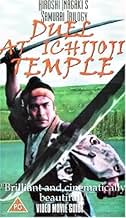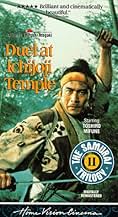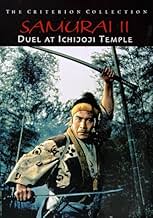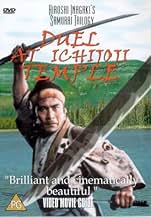IMDb RATING
7.3/10
7.3K
YOUR RATING
Musashi Miyamoto returns to Kyoto after years of absence. After a series of fights against the Yoshioka School, he challenges its master to a duel.Musashi Miyamoto returns to Kyoto after years of absence. After a series of fights against the Yoshioka School, he challenges its master to a duel.Musashi Miyamoto returns to Kyoto after years of absence. After a series of fights against the Yoshioka School, he challenges its master to a duel.
Featured reviews
This comment about the "Samurai Trilogy" starts on the page for Miyamoto Musashi (Samurai I). My first viewing of the second episode was memorable because I got to take the train into town all by myself, and view it in a Tokyo theater. The first episode had just been shown on base, in a sort of cultural exchange, and my parents saw it and were pleasantly non-outraged-- I was a 9-year-old samurai-movie addict, and they believed enthusiasm beyond a certain intensity should be curbed. It was the same conflict as comic books some few years earlier. Technicolor was a big deal back then, especially in Japan, and it became the issue on which my viewing of "swordfighting movies" was decided-- the ones in color were historical films worth viewing, and even had something to teach. The black-and-white ones shown in Irumagawa and surrounding villages-- I had to sneak off to see. Ichijoji no Ketto (Duel at Ichijoji Temple) shows Miyamoto-san's achievements, while barring no holds on the issue of what they cost him. The romantic subplot continues, though its development in the western sense (toward union, wedded bliss) is thwarted at every turn. The issue is always a conflict between love and duty, and each deferment of gratification spells out a new step in the redefinition of the national character that is being mapped here. Again, some of the importance of all this is lost, even to modern Japanese audiences for whom the issues are long settled-- at the time, though, they were cliffhangers. A new character is introduced, Kojiro Sasaki who will emerge in part 3 as a rival for Musashi-- his equal except for certain features in their respective character. By the way, the score is excellent and haunting-- it extends like a symphony through all three parts, and has a leitmotif "hook" that will cause your ears to pick up in recognition, perhaps years from now, when you hear it again.
The great cast that was in Musashi Miyamoto, the first part of this samurai trilogy continues in the second part with a few additions.
By this time Musashi Miyamoto has been on the road for three years and is still learning. The most important lesson as a Samurai will not be learned until the film is almost over. Another important lesson comes quickly after that, and it will interesting to see how it plays out in the final part.
In the opening Musashi Miyamoto is doing battle with a samurai similar to our buddy Hanzo. They are the only two I have ever seen use chains.
After this he heads to Kyoto to do battle with the best in the capital, and also to get himself mixed up with the two women who are in love with him.
Love, fickleness, treachery, rape, revenge, honor, and great sword fighting all have a place in this magnificent film.
The amazing cinematography and scenery also place an important part.
This is truly a samurai classic.
By this time Musashi Miyamoto has been on the road for three years and is still learning. The most important lesson as a Samurai will not be learned until the film is almost over. Another important lesson comes quickly after that, and it will interesting to see how it plays out in the final part.
In the opening Musashi Miyamoto is doing battle with a samurai similar to our buddy Hanzo. They are the only two I have ever seen use chains.
After this he heads to Kyoto to do battle with the best in the capital, and also to get himself mixed up with the two women who are in love with him.
Love, fickleness, treachery, rape, revenge, honor, and great sword fighting all have a place in this magnificent film.
The amazing cinematography and scenery also place an important part.
This is truly a samurai classic.
The tale of Myamoto Musashi - thief, lover, rogue, then warrior, hero and master - is enshrined in Japanese culture, perfect showcase material as it were. It has been adapted more than once to the screen, and Inagaki's classy, colorful version is perhaps the best known. It is everything you'd expect from a period samurai film if you've never seen one and harbor no negative preconceptions.
After a playful first part that has a classic hero's journey structure, part II takes things to the next level without having to rush to the finish, and is the more interesting film. It allows the hero to wield his newfound power without the restraint and inner peace he will later find. It allows him the get mad, and nobody does unleashed fury like Toshiro Mifune, not when you throw 80+ armed fools in this way.
I chose to review this one because it is a good sample of the very best this trilogy accomplishes: compelling archetypical characters, lush cinematography and that "oriental" elegance that always seduces non-Japanese audiences, drawn in as they are by the very universal plot and character dynamics.
I cannot put it in the same leagues as the masterpieces of Kurosawa, Ozu and Kobayashi, but if it is to be a gateway film experience, then it is a bloody good one, and laudable for what it accomplishes.
You might really enjoy this, and if you do, it's just the beginning!
After a playful first part that has a classic hero's journey structure, part II takes things to the next level without having to rush to the finish, and is the more interesting film. It allows the hero to wield his newfound power without the restraint and inner peace he will later find. It allows him the get mad, and nobody does unleashed fury like Toshiro Mifune, not when you throw 80+ armed fools in this way.
I chose to review this one because it is a good sample of the very best this trilogy accomplishes: compelling archetypical characters, lush cinematography and that "oriental" elegance that always seduces non-Japanese audiences, drawn in as they are by the very universal plot and character dynamics.
I cannot put it in the same leagues as the masterpieces of Kurosawa, Ozu and Kobayashi, but if it is to be a gateway film experience, then it is a bloody good one, and laudable for what it accomplishes.
You might really enjoy this, and if you do, it's just the beginning!
Samurai II picks up where the first film left off; Takezo, now Miyamoto Musashi (Toshiro Mifune) has been released by the priest and is clearly more disciplined after having absorbed his teaching. After we see him dispatch a foe swinging a wicked kusarigama, however, an old man who's witnessed the affair comments that he lacks chivalry, and taking this next step in his development is the subject of this installment in the trilogy. Mifune is wonderful and joined by many of the characters from the first film, as well as the leader of an unscrupulous samurai school (Akihiko Hirata) and another samurai, Sasaki Kojiro, who is clearly on the path to higher development (Koji Tsuruta). Unfortunately, while there are some really fine moments, narratively the film is bit tangled, which kept me from truly loving it.
For one thing, I think it was a mistake to have Musashi meet Otsu (Kaoru Yachigusa) again so early in the story, then to have another dramatic scene where he tells her he's chosen the way of the sword instead of the way of love, since this had already had been done with great effectiveness at the end of the first film. Later he's also tempted by a courtesan in a scene reminiscent of the widow and her daughter trying to seduce him, and naturally, he rebuffs her too. The main story line is Musashi and it consists mostly of him turning down women throwing themselves at his feet or being hunted by his enemies, which I didn't find all that creative.
Meanwhile, there are lots of other subplots, none of which are satisfying. There is one involving the widow's daughter (Mariko Okada), who is in part a sympathetic character because she's prostituted by her own mother, but also in part a villain, lying to Otsu by telling her that Musashi is hers, and trying to steal him as she did with Otsu's fiancé Matahachi (Sachio Sakai) in the first film. The cowardly Matahachi has fallen into ignominy, and along with his venomous mother become threats out of "honor" to the family name. A brother to the leader of the samurai school gets in the act and also wants to challenge Musashi out of honor. While there is a lot of talk about honor from these kinds of characters, what we actually see is a lot of dishonorable behavior from everyone other than Musashi, Otsu, the priest, and Sasaki. I liked the contrast formed between good and evil, but just felt the number of characters involved could have been reduced to allow for more depth on the others. I have to say, I also disliked the ending, and not just because it was predictable. It's great that Musashi knows that "no means no," and it's a contrast to the rape another man commits earlier in the film, but his response was also pretty flawed.
All of that complaining aside, this is certainly a decent samurai film and it had its moments. Even though the film didn't seem to have a terribly large budget and the scenes shot at the studio are obvious, the cinematography is excellent. The swirling scenes leading up to battle and how colors are often contrasted with dark backgrounds are wonderful. The final battle sequence out in the rice paddy was very well filmed, and the taut precision of the samurai form was beautifully brought out by Mifune. From the perspective of craftsmanship it may be better than the first film, but from the perspective of narrative, it was a step down. Still, it's worth seeing.
For one thing, I think it was a mistake to have Musashi meet Otsu (Kaoru Yachigusa) again so early in the story, then to have another dramatic scene where he tells her he's chosen the way of the sword instead of the way of love, since this had already had been done with great effectiveness at the end of the first film. Later he's also tempted by a courtesan in a scene reminiscent of the widow and her daughter trying to seduce him, and naturally, he rebuffs her too. The main story line is Musashi and it consists mostly of him turning down women throwing themselves at his feet or being hunted by his enemies, which I didn't find all that creative.
Meanwhile, there are lots of other subplots, none of which are satisfying. There is one involving the widow's daughter (Mariko Okada), who is in part a sympathetic character because she's prostituted by her own mother, but also in part a villain, lying to Otsu by telling her that Musashi is hers, and trying to steal him as she did with Otsu's fiancé Matahachi (Sachio Sakai) in the first film. The cowardly Matahachi has fallen into ignominy, and along with his venomous mother become threats out of "honor" to the family name. A brother to the leader of the samurai school gets in the act and also wants to challenge Musashi out of honor. While there is a lot of talk about honor from these kinds of characters, what we actually see is a lot of dishonorable behavior from everyone other than Musashi, Otsu, the priest, and Sasaki. I liked the contrast formed between good and evil, but just felt the number of characters involved could have been reduced to allow for more depth on the others. I have to say, I also disliked the ending, and not just because it was predictable. It's great that Musashi knows that "no means no," and it's a contrast to the rape another man commits earlier in the film, but his response was also pretty flawed.
All of that complaining aside, this is certainly a decent samurai film and it had its moments. Even though the film didn't seem to have a terribly large budget and the scenes shot at the studio are obvious, the cinematography is excellent. The swirling scenes leading up to battle and how colors are often contrasted with dark backgrounds are wonderful. The final battle sequence out in the rice paddy was very well filmed, and the taut precision of the samurai form was beautifully brought out by Mifune. From the perspective of craftsmanship it may be better than the first film, but from the perspective of narrative, it was a step down. Still, it's worth seeing.
I've watched the entire trilogy of the Musashi Miyamoto films, of which this film is the second part. The first film, titled simply "Musashi Miyamoto," introduces us to the characters of this and the third film. Without having seen the first film and developing some interest in the welfare of the characters, I certainly wouldn't have sat through the second and third films.
"Duel at Ichijoji Temple," this film, deals with Musashi's exploits as a sort of samurai knight-errant, seeking glory in a very ambiguous and roundabout way. Two women are trailing after him, as Kurosawa films would say, "like goldfish dung." Musashi himself is a flat character on whom Toshiro Mifune's acting skills are wasted. He displays very little emotion or intellect, despite his supposed interest in one of the women and enlightening education by his monk teacher (as we saw in the first film).
If Musashi is flat, the female characters are steamrolled. Their hand wringing, collapsing, and sobbing is typical of American movies of this time period and grows tedious in a samurai film. Having seen other films from this time period set in the days of samurai, I've seen that much more can be done with female characters. The plot was likewise predictable and slow-moving.
If you don't care about characters or plot, the high points of the movie may compensate: beautiful color landscapes and Toshiro Mifune's thrilling fight scenes. Otherwise, I recommend films by Kurosawa or Mizoguchi ("Sanjuro," the mysterious "Ugetsu") over this trilogy. 5/10
"Duel at Ichijoji Temple," this film, deals with Musashi's exploits as a sort of samurai knight-errant, seeking glory in a very ambiguous and roundabout way. Two women are trailing after him, as Kurosawa films would say, "like goldfish dung." Musashi himself is a flat character on whom Toshiro Mifune's acting skills are wasted. He displays very little emotion or intellect, despite his supposed interest in one of the women and enlightening education by his monk teacher (as we saw in the first film).
If Musashi is flat, the female characters are steamrolled. Their hand wringing, collapsing, and sobbing is typical of American movies of this time period and grows tedious in a samurai film. Having seen other films from this time period set in the days of samurai, I've seen that much more can be done with female characters. The plot was likewise predictable and slow-moving.
If you don't care about characters or plot, the high points of the movie may compensate: beautiful color landscapes and Toshiro Mifune's thrilling fight scenes. Otherwise, I recommend films by Kurosawa or Mizoguchi ("Sanjuro," the mysterious "Ugetsu") over this trilogy. 5/10
Did you know
- TriviaMusashi Miyamoto (Toshiro Mifune) is seen carrying two swords. This was a samurai custom known as daisho. Translated this means 'big-little'. The bigger of the two blades was the curved katana, which was generally used for combat and duelling. The short sword was the wakizashi, this blade was generally associated with committing seppuku, however, as can be seen in the film was also used for combat.
- GoofsMany of the guys killed in swordplay go down with either no visible contact between their bodies and a katana, or appear to be hit in the arm or leg with a non-fatal slash that stills ends them, regardless.
- Quotes
Musashi Miyamoto (Takezo): I renounce my love of women.
- ConnectionsFeatured in La Voie de la lumière (1956)
- How long is Samurai II: Duel at Ichijoji Temple?Powered by Alexa
Details
- Release date
- Country of origin
- Language
- Also known as
- Samurai II: Duel at Ichijoji Temple
- Filming locations
- Production company
- See more company credits at IMDbPro
- Runtime1 hour 44 minutes
- Sound mix
- Aspect ratio
- 1.37 : 1
Contribute to this page
Suggest an edit or add missing content

































